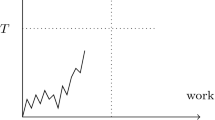Abstract
Semi‐Markovian processes (SMP) serve as a versatile means to model various traffic types generated by sources or superposed from links in ATM networks. An efficient discrete time analysis method is proposed for SMP/G/1 queueing systems to evaluate ATM switches with non‐renewal input. Some basic results are derived for the autocorrelation function of semi‐Markovian processes and for the effect of state space reduction on autocorrelation, which show how to represent correlated traffic with given characteristic by an adequate SMP model of limited size.
Similar content being viewed by others
References
N. Akar and E. Arikan, Markov modulated periodic arrival process offered to an ATM multiplexer, Performance Evaluation 22 (1995) 175–190.
V.N. Bhat, Renewal approximations of the switched Poisson processes and their applications to queueing systems, J. Oper. Res. Soc. 45 (1994) 281–286.
G.R. Bitran and S. Dasu, Approximating nonrenewal processes by Markov chains: Use of super-Erlang (SE) chains, Oper. Res. 41 (1993) 903–923.
H. Bruneel and B. Kim, Discrete-Time Models for Communication Systems Including ATM (Kluwer, 1993).
M.L. Chaudhry, Alternative numerical solutions of stationary queueing-time distributions in discrete-time: GI/G/1, J. Oper. Res. Soc. 44 (1993) 1035–1051.
W. Ding, A unified correlated input process model for telecommunication networks, in: Proceedings 13th Internat. Teletraffic Congress, Copenhagen, eds. A. Jensen and V.B. Iversen (1991) pp. 539–544.
K.M. Elsayed, On the superposition of discrete-time Markov renewal processes and application to statistical multiplexing of bursty traffic sources, in: Proceedings IEEE GLOBECOM (1994) pp. 1113–1117.
J. Filipiak, Accuracy of traffic modeling in fast packet switching, IEEE Trans. Comm. 40 (1992) 835–846.
N.D. Geogarnas, Self-similar (”fractal”) traffic in ATM networks, in: '94, Heidelberg, Lecture Notes in Computer Science 868 (Springer, New York, 1994) pp. 1–7.
W.K. Grassmann and J.L. Jain, Numerical solutions of the waiting time distribution and idle time distribution of the arithmetic GI/G/1 queue, Oper. Res. 37 (1989) 141–150.
G. Haßlinger, A polynomial factorization approach to the discrete time GI/G/1/(N) queue size distribution, Performance Evaluation 23 (1995) 217–240.
G. Haßlinger, Single server queues with semi-Markovian input: Workload based discrete time analysis and applications, '97 on Measurement, Modelling and Performance Evaluation in Computing and Communication Networks, Freiberg, Germany, submitted.
G. Haßlinger and M. Adam, Some basic properties of the autocorrelation function of semi-Markovian processes, Internal Report, Institute of Computer Science, University of Darmstadt (1995).
G. Haßlinger and E.S. Rieger, Analysis of open discrete time queueing networks: A refined decomposition approach, J. Oper. Res. Soc. 47 (1996) 640–653.
H. Heffes and D.M. Lucantoni, A Markov modulated characterization of packetized voice and data traffic and related statistical multiplexer performance, IEEE J. Selected Areas Comm. 4 (1986) 856–867.
F. Hübner and P. Tran-Gia, Performance of a finite capacity asynchronous multiplexer with modulated input, Telecommunication Systems 1 (1993) 263–278.
D. Jagerman and B. Melamed, The transition and autocorrelation structure of TES processes: General theory, Comm. Statist. Stochastic Models 8 (1992) 193–219.
P.J. Kühn, Approximate analysis of general queueing networks by decomposition, IEEE Trans. Comm. 27 (1979) 113–126.
S.-Q. Li, A general solution technique for discrete queueing analysis of multimedia traffic on ATM, IEEE Trans. Comm. 39 (1991) 1115–1132.
B. Maglaris, D. Anastassiou, P. Sen, G. Karlsson and J. Robbins, Performance models of statistical multiplexing in packet video communications, IEEE Trans. Comm. 36 (1988) 834–843.
S.V. Raghavan, D. Vasukiammaiyar and G. Haring, Hierarchical approach to building generative networkload models, Computer Networks and ISDN Systems 27 (1991) 1193–1206.
E.S. Rieger and G. Haßlinger, An analytical solution to the discrete time single server queue with semi-Markovian arrivals, Queueing Systems 18 (1994) 69–105.
B. Sengupta, The semi-Markovian queue: Theory and applications, Comm. Statist. Stochastic Models 6 (1990) 383–413.
K. Sriram and W. Whitt, Characterizing superposition arrival processes in packet multiplexers for voice and data, IEEE J. Selected Areas Comm. 4 (1986) 833–846.
H.C. Tijms, Heuristics for the loss probability in finite-buffer queues, in: Proceedings of Conference on Appl. Prob. in Engineering, Computer and Comm. Sciences, Paris (1993) pp. 156–157.
W. Whitt, The queueing network analyser, Bell Syst. Techn. J. 62 (1983) 2779–2843.
Author information
Authors and Affiliations
Rights and permissions
About this article
Cite this article
Haßlinger, G. Semi‐Markovian modelling and performance analysis of variable rate traffic in ATM networks. Telecommunication Systems 7, 281–298 (1997). https://doi.org/10.1023/A:1019180514145
Issue Date:
DOI: https://doi.org/10.1023/A:1019180514145




